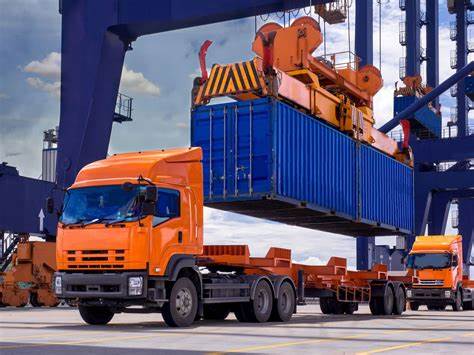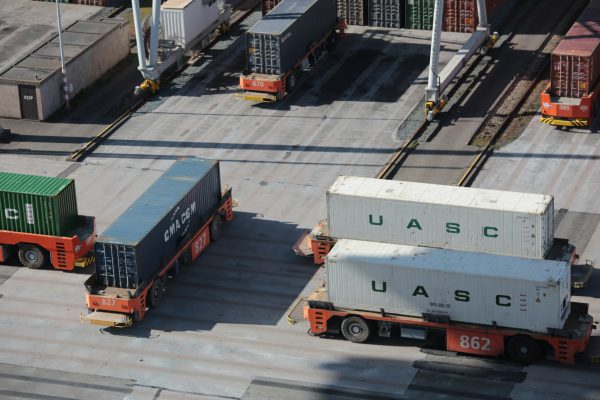We live in an era of an interconnected global economy, which has made modern supply chains highly vulnerable to external shocks. As the pandemic showed, even a single event can send ripples across entire chains and expose businesses to undue delays that can hurt their growth.
The foundation of supply chains is intermodal transportation networks that are used to move freight across vast distances. 41.8% of total freight volume in 2023 involved intermodal shipping—combining two or more modes of transportation, including rail, sea, and road, for delivering international shipments. Intermodal drayage serves as a crucial linkage point in logistics operations, but it is not without its challenges that have to be met for well-functioning supply chain networks.
The Basics of Intermodal Drayage
In order to understand what intermodal drayage is all about, it’s important to be aware of drayage meaning. It is a method of transport that involves the use of trucks for moving freight, typically in containers or trailers, over short distances from a port or rail terminal to the final customer.
Intermodal drayage logistics can be seen as a multi-modal logistics strategy with different transportation modes acting together to ensure goods get seamlessly delivered to their destination. Unlike direct shipping, intermodal transport starts and ends with trucking, although alternative transportation modes such as rails and ships are used for transferring goods at different points in the cargo journey. This helps to speed up delivery and overcome any bottlenecks that may occur when only trucking is used.

Role of intermodal Drayage in Logistics
Let’s explore intermodal drayage in action. The journey starts with a drayage container packed with goods at a warehouse or distribution facility, where a drayage truck transports them to a port or intermodal rail terminal. Subsequently, the container is transferred onto a ship or a train that carries it to another city or region. On arriving at a transloading facility closer to the port or rail terminal, the container is off-loaded and picked up by a second truck for the last-mile journey to the final destination, such as a retail store, warehouse, or distribution center.
By giving businesses the flexibility to choose the most suitable form of transport for carrying goods, intermodal drayage helps reduce shipping costs and transit times. By tapping into the strengths of truck and rail drayage as per your logistics needs, businesses can achieve greater control over their shipments and boost their competitive advantage. There is also the advantage of greater capacity in switching between transport modes, such as from a truck to rails, as a single rail can carry four truckloads worth of freight. This minimizes fuel usage way along the way and leads to a lower carbon footprint, which is critical for sustainable supply chains.
Common Challenges in Intermodal Logistics
1. Extended Timelines
While intermodal trucking gives you a distinct cost advantage, this is set off against its slower pace compared to other methods. The fact that your shipment is switching between alternative modes of transport means it can remain at a standstill for days and even weeks. It’s necessary to factor in these delays, especially if you have an urgent delivery to make.
2. Inefficient Planning or Lack of Coordination
The success of intermodal drayage relies on how well-coordinated the parties are to ensure that your shipping follows the planned routes efficiently. In case an error occurs along the way and is not communicated to all parties, this can result in a delayed cargo delivery.
3. Uncertainties In The External Environment
Delays may also be caused by certain external factors that can wreak havoc with your schedule. For example, your drayage truck might meet uncertain weather, excessive traffic on highways, or an unfortunate accident that can prevent it from following the designated journey. Delays may also occur at the point of origin, ports where weather conditions can interfere with the regular loading and unloading of containers.
4. Lack of Infrastructure
Since intermodal drayage involves containers for the most part, it depends on relevant manpower and equipment, such as cranes and forklifts, to unload and pick up containers. The absence of the right equipment at the right place makes it virtually impossible to use this method, particularly in the case of bulk shipments.
5. Container Availability and Costs
At the same time, the demand for containers has increased exponentially, particularly with the rise in global trade and the growing trend towards online shopping. More often than not, containers are stacked with goods, which means that there is a lack of empty containers while older containers are being disposed of at a faster rate than new ones are being built. Businesses can rent these from drayage carriers, but this comes at a high cost, which can be cost-prohibitive for those with limited budgets.

Solutions to Intermodal Shipping Challenges
Buy Used containers
Businesses that are eager to use intermodal drayage and lack resources can benefit from purchasing used shipping containers instead of new ones. It not only provides you with much-needed space to transport cargo but also at a lower upfront cost while adding to the efficiency of your operations.
Work with Drayage Service Provider
The fact that the intermodal load remains in the same container without its contents being sorted out or packaged means a relatively simplified shipping process. However, the use of a drayage service can serve to coordinate various legs of your cargo’s journey to ensure it reaches swiftly and safely. These services provide customized solutions tailored to your shipping needs to yield the best outcomes for your business.
Include Railroads in your Shipping Routes
About 40% of the total freight volume in the US for long-haul transport
is handled by freight railroads, which offer a convenient means to escape the highly congested ports and highways. You can enlist help from trucking companies who get hold of your container at a port and transport it to a rail terminal, loaded onto rail cars to cover the last long-mile distance before final delivery. This way, you can keep your containers from staying stuck at ports for an extended time.
Collaborate with all Stakeholders
Companies can enhance communication by ensuring that all parties are aligned before signing up for a shipment. The clients should stay in the loop with the drayage trucking companies to keep up-to-date with the logistics process and account for any glitches or setbacks that occur along the road. You can use communication apps like WhatsApp or Zoom to discuss details about the transport and how it will be executed to avoid any misunderstanding later on.
FAQs
1. What Factors to Consider When Choosing Intermodal Drayage Providers?
Selecting the right drayage provider can be a make-or-break factor in your logistics operations. Prefer well-reputed providers with proven experience in intermodal transportation and capable of catering high-volume shipments. Also, make sure that the provider is reliable with a strong safety and customer service record to ensure you invest in the right place.
2. How Intermodal Trucking Improves Freight Efficiency and Delivery Times
Intermodal drayage incorporates multiple modes of transport in its logistics plan, which helps in picking the most efficient routes, resulting in fast and reliable delivery. This approach is valuable when cargo has to be moved within a set deadline while reducing costs to help you meet customer demands confidently.
3. How Can Businesses Minimize Delays In Intermodal Drayage?
Companies can deploy tracking technologies with abilities to track cargo in real-time, schedule pick-ups for off-peak periods, utilize diverse ports to avoid port congestion, and lastly partner with reliable drayage providers. A proactive approach to planning routes and adding buffer time to shipping schedules makes shipments resilient to unexpected disruptions.
4. How Can Businesses Reduce Costs in Intermodal Freight Transport?
Businesses can adopt various cost-cutting strategies, such as optimizing the use of container loads and consolidating multiple orders into shipments to avail lower per-unit shipping costs. They can also harness insights from predictive analytics to anticipate shifts in customer demands to mold their logistics strategy accordingly to further minimize unnecessary costs.
Conclusion
Intermodal transportation seamlessly integrates multiple transport modes, which facilitates the movement of cargo from ports or rail stations to their destinations. From a logistics perspective, it provides numerous benefits like cost savings, improved efficiency, and sustainability, making it the go-to method for shipping goods within and across borders.
At Accurate Trailers, we are geared to streamline the shipping process from the beginning to the end to fulfil your shipping needs. Contact us for a free quote to get the support to overcome challenges related to intermodal drayage for more resilient and efficient supply chains.